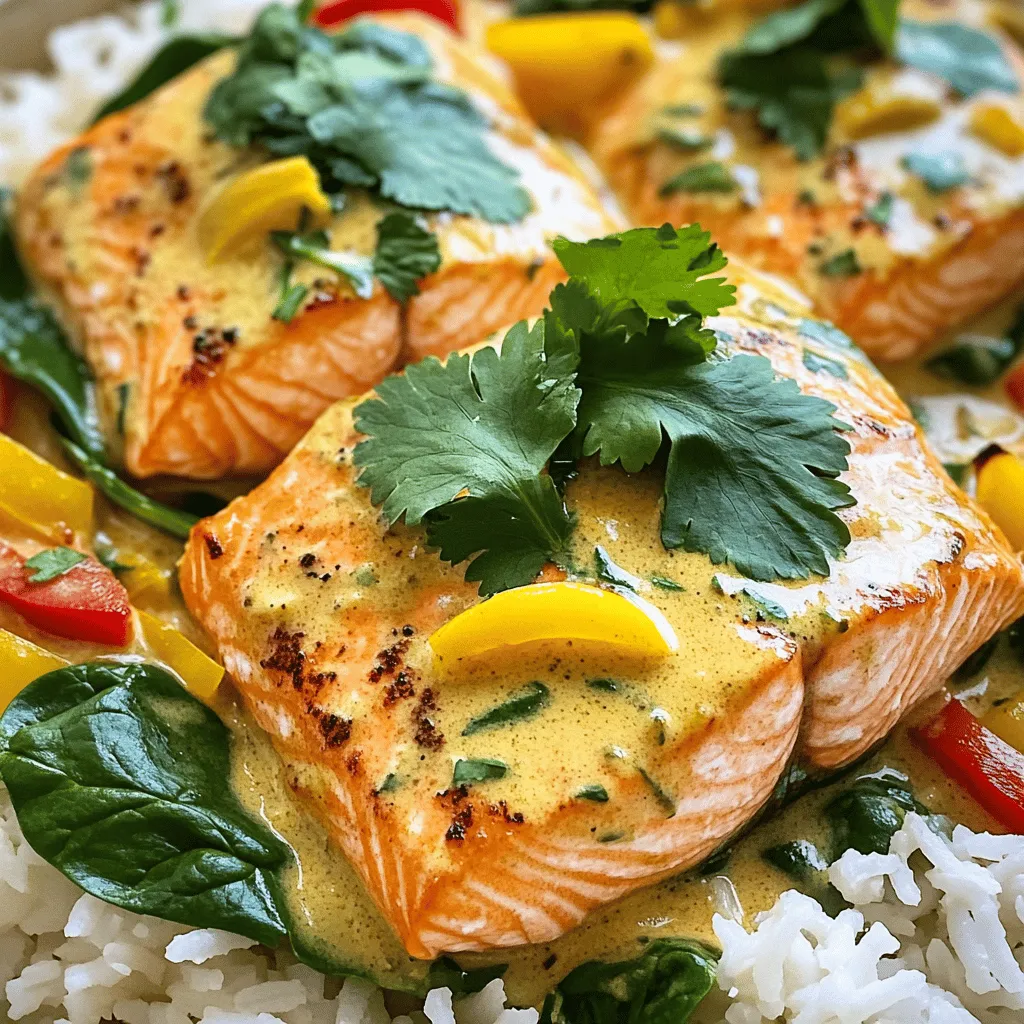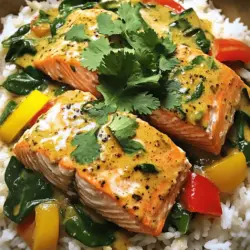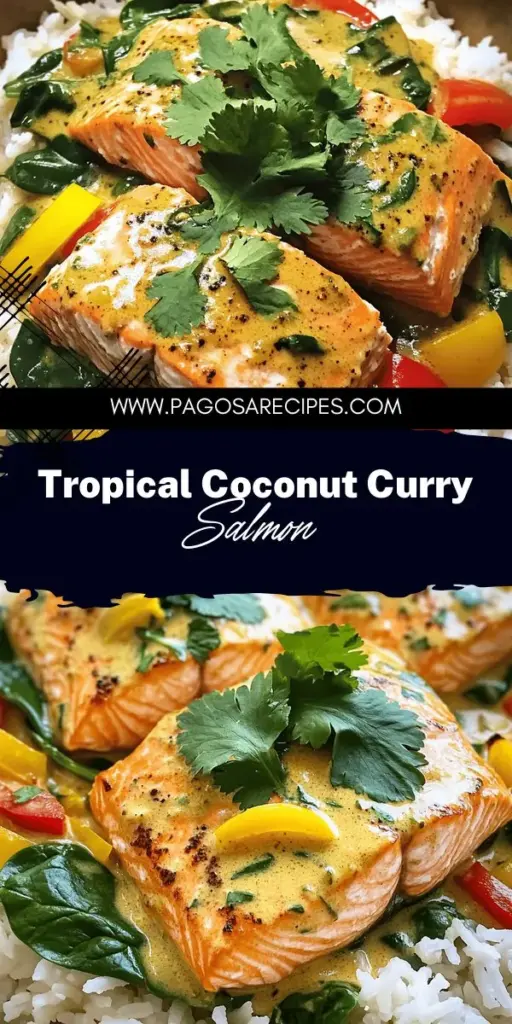Ready to make a meal that sings with flavor? Caribbean-Style Coconut Curry Salmon is your answer! This tasty recipe blends fresh ingredients with bold spices, bringing the spirit of the tropics to your kitchen. In this post, I’ll share easy steps, helpful tips, and quick info on the best ingredients. Let’s dive into a sunny dish that will impress your family and friends!
Ingredients
Detailed Ingredients List
For this Caribbean-Style Coconut Curry Salmon, you will need:
- 4 salmon fillets (6 oz each)
- 1 can (13.5 oz) coconut milk
- 2 tablespoons red curry paste
- 1 tablespoon olive oil
- 1 onion, finely chopped
- 3 garlic cloves, minced
- 1 tablespoon ginger, grated
- 1 bell pepper (red or yellow), sliced
- 1 cup baby spinach
- 1 tablespoon lime juice
- Salt and pepper to taste
- Fresh cilantro for garnish
- Cooked jasmine rice or quinoa for serving
Nutritional Information
This dish is not just tasty; it’s also healthy! Each serving contains:
- Calories: 400
- Protein: 30g
- Fat: 25g
- Carbohydrates: 20g
- Fiber: 3g
- Sugar: 5g
These numbers can change based on your ingredients. For example, using light coconut milk can cut fat and calories. Overall, this meal provides a good balance of protein and healthy fats.
Quality Tips for Ingredients
To make your curry shine, choose fresh ingredients. Here are some tips:
- Salmon: Look for wild-caught salmon. It has better flavor and nutrients.
- Coconut Milk: Use full-fat coconut milk for a creamier texture. Shake the can well before using.
- Red Curry Paste: Check for brands that use natural ingredients. This ensures a rich taste without additives.
- Veggies: Pick firm bell peppers and fresh spinach. They add color and crunch to your dish.
Using high-quality ingredients makes a big difference in taste. Trust me, your meal will thank you!
Step-by-Step Instructions
Easy Cooking Process
To make this Caribbean-Style Coconut Curry Salmon, you start by gathering your ingredients. Here’s a quick rundown of the steps:
1. Heat the skillet: Pour olive oil into a large skillet and warm it over medium heat.
2. Sauté onion: Toss in the chopped onion. Cook for 3-4 minutes until it turns soft and clear.
3. Add garlic and ginger: Stir in minced garlic and grated ginger. Cook for one more minute.
4. Cook bell pepper: Add the sliced bell pepper. Let it cook for about 3 minutes.
5. Mix in curry paste: Add red curry paste. Stir and cook for 1-2 minutes to blend the flavors.
6. Pour coconut milk: Add the can of coconut milk. Stir until it all mixes well. Let it simmer for 5 minutes.
7. Season the sauce: Taste and add salt, pepper, and lime juice as needed.
8. Add salmon: Place the salmon fillets in the sauce, skin side down. Spoon sauce over the top.
9. Cover and cook: Cover the skillet. Let the salmon cook for 8-10 minutes until it flakes easily.
10. Add spinach: Two minutes before the salmon is done, add baby spinach. Stir until it wilts.
11. Let it rest: Remove the skillet from heat. Let it sit for a couple of minutes before serving.
Visual Guide for Each Step
You can imagine each step as a colorful adventure. Each ingredient adds its own flair. The onions become golden, the peppers brighten the dish, and the salmon glows. The coconut milk transforms into a rich sauce that looks inviting. While I cannot show pictures, I encourage you to visualize this process as you cook.
Tips for Perfect Cooking
- Fresh Ingredients: Always choose fresh salmon for the best flavor.
- Don’t Overcook: Remove salmon from heat once it flakes easily. Overcooking makes it dry.
- Adjust Spice Level: If you like heat, add more red curry paste. For less spice, use just a bit.
- Garnish: Fresh cilantro adds a touch of brightness and flavor.Enjoy making this delightful dish!
Tips & Tricks
Best Practices for Flavor Enhancement
To boost the flavor of your Caribbean-Style Coconut Curry Salmon, use fresh ingredients. Fresh herbs, like cilantro, add great taste. Squeeze fresh lime juice for a bright kick. You can also marinate the salmon for 30 minutes. A simple mix of lime juice, salt, and a touch of curry paste works well. This step enhances the taste before cooking.
Common Mistakes to Avoid
One big mistake is overcooking the salmon. Cook it just until it flakes easily. This keeps it moist and tender. Another mistake is not seasoning enough. Always taste your sauce and adjust with salt and pepper. Lastly, don’t skip the spinach. It adds nutrients and color, making the dish visually appealing.
How to Achieve Perfectly Cooked Salmon
To cook salmon perfectly, keep an eye on the heat. Medium heat is key for even cooking. Always place the salmon skin side down in the sauce. This helps the skin crisp and the fish stay moist. Cover the skillet while cooking. This traps steam and cooks the salmon evenly. After cooking, let it rest for a couple of minutes. This step helps the juices settle and keeps the salmon flavorful.

Variations
Alternative Ingredients and Substitutes
You can easily change some ingredients in this recipe. If you want a milder flavor, use yellow curry paste instead of red. You can swap salmon for other fish, like tilapia or cod. For a different taste, try using shrimp or chicken. If you are out of coconut milk, use unsweetened almond milk or cashew cream. This will give a nice creamy texture, though the taste will be a bit different. You can also add more veggies, like zucchini or carrots, for extra nutrition and color.
Suggested Side Dishes
This curry pairs well with many sides. Serve it over jasmine rice or quinoa to soak up the sauce. You can also try it with coconut rice for a tropical twist. A simple green salad with lime vinaigrette adds a crisp contrast. Grilled or roasted vegetables make a great side, too. For a refreshing touch, serve it with sliced avocado and lime wedges.
Vegan/Vegetarian Versions
You can make this dish vegan easily. Replace salmon with firm tofu or chickpeas. Make sure to press the tofu to remove extra water. Use the same cooking method to enjoy the creamy curry flavor. Instead of fish sauce, use soy sauce or tamari for a salty kick. Using vegetable broth in place of chicken broth can enhance the flavor, too. This way, everyone can enjoy a delicious meal.
Storage Info
How to Store Leftovers
After enjoying your Caribbean-Style Coconut Curry Salmon, you want to store any leftovers properly. Place the salmon in an airtight container. Make sure to spoon some sauce over the fish. This keeps the salmon moist. Store it in the fridge. It will last for 2 to 3 days. If you want to keep it longer, consider freezing.
Reheating Instructions
To reheat your salmon, use a gentle method. You can microwave it or warm it on the stove. If using the microwave, cover the dish to avoid drying out. Heat in short bursts of 30 seconds until warm. If reheating on the stove, add a splash of water or coconut milk. This helps keep the fish moist.
Freezing for Later Use
If you plan to freeze your leftovers, let them cool first. Place the salmon and sauce in a freezer-safe container. Make sure to label it with the date. You can freeze it for up to 2 months. When you’re ready to enjoy it again, thaw it in the fridge overnight before reheating. This keeps the flavors fresh and delicious.
FAQs
What can I serve with Caribbean-Style Coconut Curry Salmon?
You can serve this dish with cooked jasmine rice or quinoa. Both options soak up the curry sauce well. You can also pair it with a fresh salad for crunch. A side of steamed vegetables adds color and nutrition. Consider adding mango salsa for a fruity kick. The flavors of the curry blend nicely with these sides.
Can I use frozen salmon for this recipe?
Yes, you can use frozen salmon. Just be sure to thaw it first. Place the salmon in the fridge overnight for best results. You can also use the microwave on the defrost setting. Make sure to pat it dry before cooking. This helps the salmon absorb the curry flavor better.
How do I adjust the spiciness of the curry?
To adjust the spiciness, you can add or reduce the red curry paste. Start with a small amount and taste as you go. For less spice, use half the amount. If you want it spicier, add more paste or some chili flakes. Remember, you can always add more spice, but you can’t take it away. Balance it with extra coconut milk if it gets too hot.
In this post, we covered the key ingredients and cooking steps for Caribbean-Style Coconut Curry Salmon. We explored tips for enhancing flavor and avoiding cooking errors. Variations and storage methods ensure you can enjoy this meal anytime. With clear answers to common questions, you are now prepared to create a delicious dish. Take these insights to your kitchen and enjoy making this flavorful salmon dish your own. Happy cooking!



